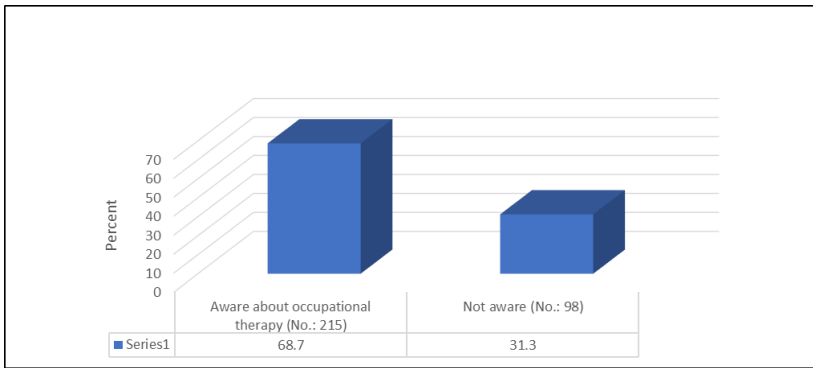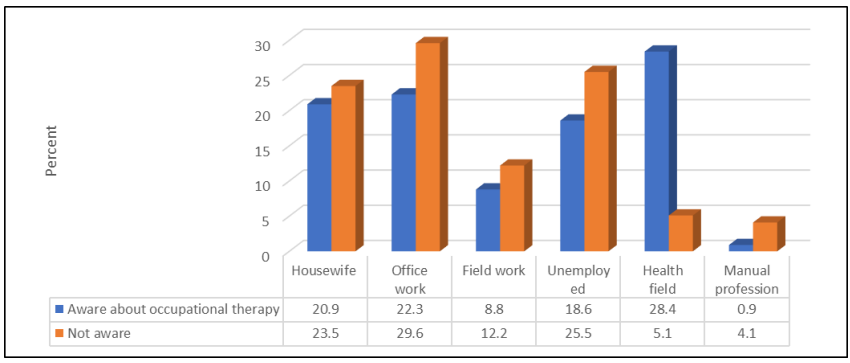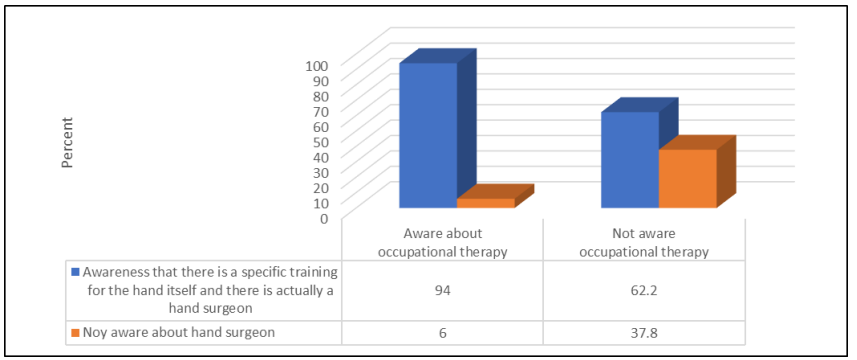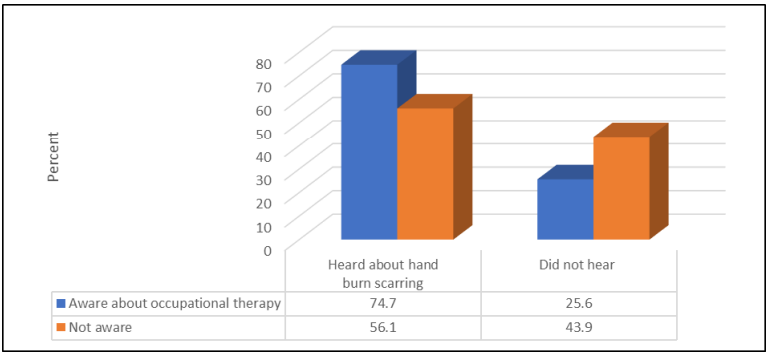Awareness and Perception of Occupational Therapy among the General Population in Jeddah, KSA
Awareness and Perception of Occupational Therapy among the General Population in Jeddah, KSA
Bayan A. Ghalimah (1)* , Saleha S. Khan (2) , Hanan M. Ahmad (3) , Najla G. Abdullah (4) , Abdurrahman H. Sultan (3) , Rasha E. Alotaibi (3) , Abdulaziz F. Aljehani (3) , Amre S. Hamdi (1) , Abdulrahman F. Bukhari (5)
(1) Department of Orthopedic Surgery, Faculty of Medicine, King Abdulaziz University, Jeddah, Saudi Arabia.
(2) College of Medicine and Surgery, Batterjee Medical College, Jeddah, Saudi Arabia.
(3) College of Medicine and Surgery, King Abdulaziz University, Jeddah, Saudi Arabia.
(4) International Medical Center Hospital, Jeddah, Saudi Arabia.
(5) Occupational Therapy Department, Dr. Sulaiman Al Habib Medical Group, Jeddah.
*Correspondence to: Bayan A. Ghalimah, Department of Orthopedic Surgery, Faculty of Medicine, King Abdulaziz University, Jeddah, Saudi Arabia.
Copyright
© 2025 Bayan A. Ghalimah This is an open access article distributed under the Creative Commons Attribution License, which permits unrestricted use, distribution, and reproduction in any medium, provided the original work is properly cited.
Received: 03 Jan 2025
Published: 17 Jan 2025
DOI: https://doi.org/10.5281/zenodo.14676337
Abstract:
Background: Occupational therapy (OT) is vital in multidisciplinary healthcare, particularly in hand surgery and rehabilitation. However, awareness of its role remains limited, affecting access and patient outcomes.
Objective: To assess awareness and perceptions of OT in managing hand pathologies and post-operative care among the general population in Jeddah, Saudi Arabia.
Methods: A cross-sectional study was conducted in Jeddah (October 2023–June 2024) during the “Together for a Healthy Hand” campaign. Data were collected via a structured questionnaire covering demographics, exposure to hand conditions, perceptions, and OT awareness. Convenience sampling was employed, and statistical analyses performed.
Results: Out of 313 participants (68.7% female), 66 (21.1%) worked in healthcare, and 77 (24.6%) in office jobs. Overall, 68.7% were aware of OT in hand management. Awareness was significantly higher among healthcare workers (28.4%) and those with prior exposure to hand conditions, particularly Carpal Tunnel Syndrome, Trigger Finger, or De Quervain’s Syndrome (p < 0.05).
Conclusion: Awareness of OT in Jeddah is moderate, with a focus on hand surgery but limited understanding of its broader scope. Targeted educational initiatives are recommended to enhance OT awareness and accessibility, improving patient outcomes and healthcare delivery.
Awareness and Perception of Occupational Therapy among the General Population in Jeddah, KSA
Introduction
Occupational therapy (OT) is an integral part of multidisciplinary healthcare, dedicated to enabling individuals to participate in meaningful daily tasks—often referred to as “occupations”—essential for overall health and wellbeing.1–3 OT serves individuals across all age groups, using therapeutic activities to facilitate engagement in self-care, work, and leisure. As a holistic, client-centered profession, OT promotes physical, mental, and emotional wellbeing. It is globally recognized by organizations such as the World Health Organization and the World Federation of Occupational Therapists.4–5
Timely rehabilitation is essential for optimal recovery, making OT services indispensable in hand surgery clinics. In hand surgery, OTs restore functional abilities through personalized interventions such as wound care, edema control, splinting, positioning, therapeutic exercises, and environmental modifications. These interventions promote recovery, independence, and a better quality of life while being cost-effective, ultimately enhancing the overall quality of healthcare delivery.6–7
Despite OT’s critical role in restoring independence and function for various hand conditions, diseases, and injuries, there remains a significant gap in awareness among both the public and the medical community regarding its importance in patient care. Many individuals, including those receiving OT services, struggle to define the role of occupational therapists, often recognizing more familiar professions such as doctors or physiotherapists.8–9 This limited awareness produces the underutilization of OT services, negatively affecting patient access to rehabilitation and overall recovery outcomes.
Research indicates that only 59.1% of medical and health-sciences students in Saudi Arabia are familiar with OT, with many expressing a desire to learn more about the profession.10 This gap in knowledge hinders the effective use of OT services and may impact recovery outcomes for patients.
The objective of this study is to assess the level of awareness and perception of OT among the public in Jeddah, Kingdom of Saudi Arabia. By identifying gaps in knowledge, this research seeks to develop strategies that can improve public education and engagement with OT services, ultimately leading to better outcomes in accessing and using these services post-surgery.
Method
A cross-sectional study was done in Jeddah, Saudi Arabia, from 1 October 2023 to 1 June 2024 during an awareness campaign titled “Together for a Healthy Hand.” Inclusion criteria were adult individuals of the Saudi public within the selected study area who consented to participate in the study. There were no specific restrictions based on age, sex, occupation, or socioeconomic status, ensuring inclusivity and a representative sample. Exclusion criteria were individuals who were unable or unwilling to provide informed consent or complete the surveys. Moreover, individuals with cognitive impairments or language barriers that hindered their ability to participate effectively were excluded to ensure the validity and reliability of the data collected.
The Raosoft online sample size calculator software was used to calculate the sample size at a 5% margin of error and 95% confidence level. The minimum calculated sample was 300 participants.
Individuals from the public were invited to participate in the study voluntarily. The participants’ data were collected during the campaign through a questionnaire that included items about demographics characteristics and awareness of OT for hand pathology, along with a hand surgeon. A pilot study with thirteen participants was conducted, and the findings were used to assess validity and reliability. A Cronbach’s alpha test was used to assess the internal consistency of the survey’s items, which was 0.78.
An ethical approval for the study was obtained from the Institutional Review Board of King Abdul Aziz University (KAU), Jeddah, Saudi Arabia.
Data were analyzed using SPSS version 26. To investigate the association between the variables, a Chi-squared test (χ2) was applied to qualitative data expressed as numbers and percentages. Quantitative data were expressed as mean and standard deviation (M ± SD), and a p-value of less than .05 was considered statistically significant.
Results
Of the 313 participants, 41.5% had an age ranging from 31–45 years, 68.7% were female, and 61.3% had a university level of education, almost one quarter (24.6%) were office workers, and 21.1% were working in the health care field (Table 1).
Table 1. Participant Demographics (No. 313)
|
Variable |
No. (%) |
|
Age (Years) |
|
|
< 17 |
12 (3.8) |
|
17–30 |
119 (38) |
|
31–45 |
130 (41.5) |
|
> 45 |
52 (16.6) |
|
Sex |
|
|
Female |
215 (68.7) |
|
Male |
98 (31.3) |
|
Educational Level |
|
|
Illiterate |
4 (1.3) |
|
Primary |
2 (0.6) |
|
Middle |
7 (2.2) |
|
Secondary |
65 (20.8) |
|
University |
192 (61.3) |
|
Master and above |
43 (13.7) |
|
Employment Status |
|
|
Housewife |
68 (21.7) |
|
Office work |
77 (24.6) |
|
Field work |
31 (9.9) |
|
Unemployed |
65 (20.8) |
|
Health field |
66 (21.1) |
|
Manual profession |
6 (1.9) |
Of the 313 participants, 215 (68.7%) were aware about the roles of OT in hand pathology (Figure 1).
Figure 1. Percentage distribution of the participants according to their awareness of OT for hand pathology along with a hand surgeon
Figure 2 demonstrate that the prevalence of awareness of OT was significantly higher among participants working in healthcare (61 [28.4%]) compared to those working in other occupations (p < .05). However, a non-significant relationship was found between awareness of OT and other demographics (p >.05).
Figure 2. Relationship Between Awareness of OT and Participant Occupations (No. 313)
N.B.: (χ2 = 24.75, p < .001)
Figure 3 shows that participants who were aware of OT were also significantly aware of hand therapies and the hand surgeon (p < .05).
Figure 3. Relationship Between Awareness of OT and Awareness of Hand Therapies and Hand Surgeon (No. 313)
N.B.: (χ2 = 10.42, p < .001)
Table 2 shows that, of the participants, most (84%) were aware of the hand therapies and the hand surgeon. Further, 68.7% were aware of the special therapist who manages hand pathology along with the hand surgeon. The prevalence of awareness of OT was significantly higher among participants who had heard about the conditions (carpal tunnel syndrome, trigger finger, ganglion cyst, De Quervain’s syndrome, and hand burn scarring; p >.05). Further, awareness about OT was significantly higher among participants diagnosed with carpal tunnel syndrome, trigger finger, and De Quervain’s syndrome (p < .05).
Table 2. Relationship Between Awareness of OT and Prevalence and Knowledge of Hand Conditions (No. 313)
|
Variable |
Total No. (%) |
Aware of OT |
χ2 |
p |
|
|
Not aware No. (%) |
Aware No. (%) |
||||
|
Have you heard of carpal tunnel syndrome? |
|||||
|
No |
194 (62) |
81 (82.7) |
113 (52.6) |
15.87 |
< .001 |
|
Yes |
119 (38) |
17 (17.3) |
102 (47.4) |
|
|
|
Have you ever been diagnosed with carpal tunnel syndrome? (No. 119) |
|||||
|
No |
98 (82.3) |
10 (10.2) |
88 (40.9) |
13.17 |
< .001 |
|
Yes |
21 (17.7) |
7 (7.1) |
14 (6.5) |
|
|
|
Have you heard of trigger finger? |
|||||
|
No |
222 (70.9) |
86 (87.8) |
136 (63.3) |
19.59 |
< .001 |
|
Yes |
91 (29.1) |
12 (12.2) |
79 (36.7) |
|
|
|
Have you ever been diagnosed with trigger finger? (No. 91) |
|||||
|
No |
75 (82.4) |
10 (10.2) |
65 (30.2) |
19.59 |
< .001 |
|
Yes |
16 (17.6) |
2 (2) |
14 (6.5) |
|
|
|
Have you heard of ganglion cyst? |
|||||
|
No |
211 (67.4) |
82 (63.7) |
129 (60) |
17.17 |
< .001 |
|
Yes |
102 (32.6) |
16 (16.3) |
86 (40) |
|
|
|
Have you heard of De Quervain’s syndrome? |
|||||
|
No |
245 (78.3) |
93 (94.9) |
152 (70.7) |
23.18 |
< .001 |
|
Yes |
68 (21.7) |
5 (5.1) |
63 (29.3) |
|
|
|
Have you ever been diagnosed with De Quervain’s syndrome? (No. 68) |
|||||
|
No |
61 (89.7) |
5 (5.1) |
56 (26) |
13.37 |
< .001 |
|
Yes |
7 (10.3) |
0 (0.0) |
7 (3.3) |
|
|
|
Have you heard of hand burn scarring? |
|||||
|
No |
98 (31.3) |
43 (43.9) |
55 (25.6) |
10.47 |
0.001 |
|
Yes |
215 (68.7) |
55 (56.1) |
160 (74.7) |
|
|
Figure 4. Relationship Between Awareness of OT and Hearing About Hand Burn Scarring (No. 313)
N.B.: (χ2 = 10.47, p = .001)
Discussion
This study aimed to assess public awareness and perceptions of OT services in Saudi Arabia specifically for hand pathologies and post-operative care. OT focuses on enabling individuals to regain the ability to perform meaningful daily activities, or “occupations,” to enhance their quality of life.4 Over nine months, we evaluated awareness of OT among 313 participants from diverse demographic backgrounds, examining how factors like age, sex, education, and occupation influenced OT awareness.
Comparatively, awareness of OT varies across regions and cultures.11–12 While our findings revealed that 68.7% of the participants were aware of OT and its role in hand surgery, there remains room for improvement, especially in differentiating OT from physical therapy. In more established healthcare systems where OT services have been integrated for longer periods, awareness may be higher.13 This suggests the need for continued efforts to increase public education and promote OT’s unique role in rehabilitation and post-surgical care.
Despite the benefits of OT, misconceptions about OT persist, with many participants perceiving it as a subset of physical therapy. Similar trends have been noted internationally.14 In our study, although 68.7% of the participants reported knowledge of OT, most struggled to identify the key differences between OT and physical therapy. Research by Berke-McLaughlin et al.15 highlighted similar findings, where in both OT-certified hand therapists and their patients valued OT’s focus on daily functional tasks but struggled to distinguish it from physical therapy. This lack of differentiation may lead to underutilization of OT services and fewer referrals, as patients and even some healthcare professionals may not fully recognize OT’s scope and benefits.
Participant occupation significantly influenced awareness levels. Healthcare professionals, who accounted for 28.4% of the sample, demonstrated greater familiarity with OT services due to their frequent exposure in clinical settings. Office workers, who made up 22.3% of participants, also showed relatively high awareness, likely due to workplace exposure to hand-related issues such as carpal tunnel syndrome, which OT can address.16 These findings emphasize the importance of healthcare providers as key advocates for OT services and the need to educate office workers, who are at higher risk of repetitive strain injuries, to improve engagement with OT services.
Our findings also revealed that personal or secondary exposure to hand pathologies impacted participants’ awareness of OT; while many participants had experience with conditions such as carpal tunnel syndrome, trigger finger, ganglion cysts, and De Quervain’s syndrome, less than 50% could articulate OT’s specific role in managing these conditions. In contrast, 74.7% of the participants familiar with burn injuries recognized OT’s role in their recovery, such as preventing joint stiffness and improving functional mobility. These results highlight a critical need to increase the visibility of OT’s contributions to managing common hand pathologies, particularly among patients with no prior exposure to OT interventions.
Despite its clinical benefits, OT faces several challenges to full integration within the Saudi healthcare system. Misconceptions about its role, coupled with limited interdisciplinary collaboration and restricted access often hinder its use. In Al Qahtani et al.’s study,17 only 52% of hand-surgery patients reported prior knowledge of OT services, with many believing OT was available exclusively in tertiary-care hospitals. These findings emphasize the need for public education and better collaboration between healthcare professionals to address these misconceptions and ensure broader accessibility of OT services.
Targeted interventions are necessary to improve OT awareness. Workshops and public awareness campaigns could educate both the public and healthcare professionals. Collaborating with hand surgeons could further emphasize OT’s critical role in post-surgical recovery. Highlighting OT’s success in specific conditions, such as burn injuries, could serve as an effective focal point for these efforts. For instance, Aghajanzade Et al.’s research18 demonstrated significant improvements in functional outcomes for burn patients after eight weeks of targeted OT interventions, reinforcing the importance of OT in promoting recovery and enhancing quality of life.
Demographic factors, such as age and sex, showed no statistically significant correlation with OT awareness in the current study. Although 61.3% of the participants held a university degree, which correlated with slightly higher awareness, misconceptions about OT’s scope were still prevalent. Similarly, while 41.5% of the participants were aged 31- 45 years, no meaningful relationship between age and awareness was observed. Future research with a larger, more diverse sample could provide deeper insights into how these factors influence OT awareness.
Limitations
This study had several limitations. First, the sample was limited to participants from Jeddah, which may restrict the generalizability of the results to other regions in Saudi Arabia. Second, reliance on self-reported awareness could introduce response bias, with participants potentially overstating or understating their familiarity with OT services. Lastly, the cross-sectional design captured awareness at a single point in time, limiting the ability to assess changes over time or in response to educational interventions. Future research using longitudinal approaches and more diverse samples across Saudi Arabia are recommended to address these limitations and provide a more comprehensive understanding of OT awareness.
Strengths
This study has several strengths that enhance the reliability of its findings. First, it is one of the few studies in Jeddah that assess public awareness of OT services related to hand conditions and post-surgical care. By focusing on a culturally relevant population, the study provides valuable insights into the Saudi population’s perception of OT, addressing a gap in regional data. Second, the study included a diverse sample with variations in age, educational background, and occupations, supporting the generalizability of findings within Jeddah. The inclusion of participants with healthcare-related occupations, who accounted for a significant proportion of the sample, adds depth to the analysis, as these individuals are critical to promoting OT services.
Lastly, the findings align with existing literature, emphasizing the need for improved public education and interdisciplinary collaboration to enhance OT use, reinforcing the study’s credibility and its practical implications.
Conclusion
This study highlights a moderate level of awareness of OT among the public in Jeddah, Saudi Arabia, with most participants recognizing OT’s role in hand surgery but lacking knowledge of its broader applications. The findings suggest a need for targeted educational initiatives, such as workshops, public campaigns, and interdisciplinary collaborations, to improve OT awareness and accessibility. Enhancing public understanding of OT’s unique contributions could lead to better patient outcomes, increased use of OT services, and overall improvements in healthcare delivery.
Acknowledgment
We would like to thank the participants who took part in this study and made this research possible. We also acknowledge the support provided by the Faculty of Medicine at King Abdulaziz University, Jeddah, Saudi Arabia.
This research was conducted in compliance with ethical standards, and ethical approval was obtained from the Institutional Review Board of King Abdul Aziz University, Jeddah, Saudi Arabia (Approval No. [Reference No 498-23]). Informed consent was obtained from all study participants.
The authors declare that they received funding for this research from the Deanship of Scientific Research at King Abdulaziz University, Grant Number (GPIP: 1455-828-2024). The authors also declare no conflicts of interest related to this study.”
References
1- Atwal A, Tattersall K, Caldwell K, Craik C. Multidisciplinary perceptions of the role of nurses and healthcare assistants in rehabilitation of older adults in acute health care. Journal of Clinical Nursing. 2006;15(11):1418–25. Available from: http://dx.doi.org/10.1111/j.1365-2702.2005.01451.x
2- Lidskog M, Löfmark A, Ahlström G. Interprofessional education on a training ward for older people: students’ conceptions of nurses, occupational therapists, and social workers. Journal of Interprofessional Care. 2007;21(4):387–99. Available from: http://dx.doi.org/10.1080/13561820701349420
3- College of Occupational Therapists: Code of Ethics and Professional Conduct: College of Occupational Therapists. British Journal of Occupational Therapy. 2005;68(11):527–32. Available from:http://dx.doi.org/10.1177/030802260506801108
4- American Occupational Therapy Association (AOTA). What is occupational therapy? 2018. Available from https://www.aota.org/About-Occupational-Therapy.aspx.
5- Stein F, Cutler S. Psychosocial Occupational Therapy: A Holistic Approach. Albany (book)
6- World Health Organization (WHO). Transformative Scale Up of Health Professional Education. 2011. Available from http://apps.who.int/iris/bitstream/10665/70573/1/who_hss_hrh_hep2011.01_eng.pdf.
7- Carswell A. Minimum standards for the education of occupational therapists: Building occupational therapy communities in WFOT member countries. Asian Journal Occupational Therapy. 2009;7(1):23–6. Available from: http://dx.doi.org/10.11596/asiajot.7.23
8- Krug E, Cieza A. Strengthening health systems to provide rehabilitation services. American Journal of Physical Medicine Rehabilitation. 2017;96(6):438–9. Available from:http://dx.doi.org/10.1097/PHM.0000000000000753
9- Meny AH, Hayat AA. Knowledge about occupational therapy in Makkah, Saudi Arabia: Where do healthcare professionals stand? Int Ann Med. 2017;1(11):6.
10- Sarsak HI. Perceptions of the occupational therapy profession among medical and health science students in Saudi Arabia. Annals Int Occupational Therapy. 2020;3(2):78–83. Available from: http://dx.doi.org/10.3928/24761222-20191125-03
11- Malkawi SH, Alqatarneh NS, Fehringer EK. The influence of culture on occupational therapy practice in Jordan. Occupational Therapy International. 2020;2020:1092805. Available from: http://dx.doi.org/10.1155/2020/1092805
12- Wan Yunus F, Ahmad Ridhuwan NF, Romli MH. The perception of allied health professionals on occupational therapy. Occupational Therapy International. 2022;2022:2588902. Available from: http://dx.doi.org/10.1155/2022/2588902
13- Newington L, Ceh D, Sandford F, Parsons V, Madan I. Supporting work participation for adults with hand and upper limb conditions: A survey of the British Association of hand therapists. Hand Therapy. 2024;29(2): 75–84. Available from: http://dx.doi.org/10.1177/17589983241238424
14- Sarsak HI. Arab healthcare professionals’ knowledge and perception of occupational therapy. Bulletin of Faculty Physical Therapy. 2022;27(1). Available from: http://dx.doi.org/10.1186/s43161-022-00098-4
15- Andrea E. Berke-McLaughlin. Occupational Therapy Certified Hand Therapists’ Perceptions of Occupational Therapy Certified Hand Therapists’ Perceptions of Remaining Rooted in Occupation in the Hand Clinic: A Remaining Rooted in Occupation in the Hand Clinic: A Phenomenological Study. 2023 Available from: https://encompass.eku.edu/cgi/viewcontent.cgi?article=1106&context=otdcapstones
16- Roll SC, Hardison ME. Effectiveness of occupational therapy interventions for adults with musculoskeletal conditions of the forearm, wrist, and hand: A systematic review. American Journal of Occupational Therapy. 2017;71(1):7101180010 p1–12. Available from: http://dx.doi.org/10.5014/ajot.2017.023234
17- AlQhtani A, Alammar AK, Alshammari M, Alqahtani AS, Alsubhi F, AlSahabi AM. Perceptions of hand surgery patients about occupational therapy. Journal of Hand Surgery Global. 2024;6(3):299–302. Available from: http://dx.doi.org/10.1016/j.jhsg.2023.12.011
18- Aghajanzade M, Momeni M, Niazi M, Ghorbani H, Saberi M, Kheirkhah R et al. Effectiveness of incorporating occupational therapy in rehabilitation of hand burn patients. Annals of Burns and Fire Disasters. 2019;32(2):147–52..

Figure 1

Figure 2

Figure 3

Figure 4
